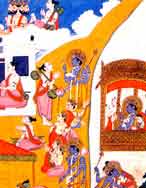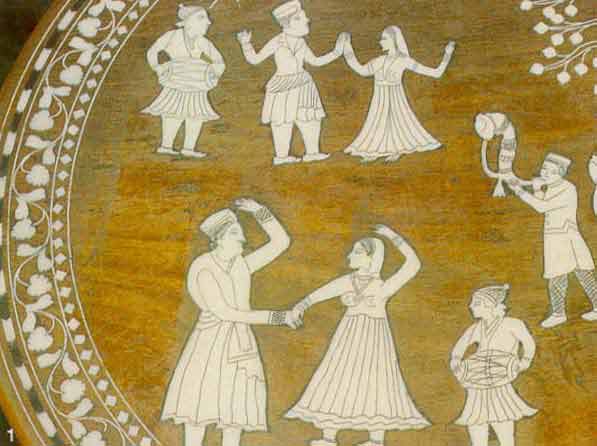|
The Pahari or Pahadi Paintings
The growth of Pahari painting can be said to have begun in Gulerkam. This
is the place that gave birth to the Chamba, Mandi, Kulu and Bilaspur styles.
The origins of the Kangra style are connected with the
name of King Sansarchand (1775-1823). The Chamba style originated during
the reign of King Raj Singh (1765-1794) of Chamba, a contemporary of king
Sansarchand of Kangra. The paintings of an artist called 'Nikka' are supposed
to depict the high watermark of this style.
The earlier painting in the Mandi style dates back to
the year 1595 and depicts king Keshav Sen of Mandi. The style reached
its apex during the reign of king Samar Sen. The Mandi style of painting
has been connected with the Basohli style and the Kulu style has been
affected by the Kangra style.
 All
these styles came to be known as the Kangra school of painting praised
lavishly by art historians like Havan and Smith. This school grew up in
the palaces of Kangra, Sujanpur and Alampur areas along the banks of the
river Beas. It deals with the subjects like scenes from the Bhagvat
Puran, Geet Govind, Ras leela, Ram leela, Shiva leela, Durga-Shakti leela,
Biharis Satsai, Rasik-Priya, Kavi-Priya, Nala-Damyanti Pranaya, the Rajmalas
and portraits of the local rulers and their families. Some of the paintings
depict the natural scenery and flora and fauna of the state. Nature usually
forms a backdrop to human figures. The paper used for these is a special
variety of hand made paper used in traditional account books (Bahi-Khata)
and is also known as the Sialkot paper. This is first covered with a layer
of a thick white liquid and then smoothed over with a conch shell. This
imparts the paper a firmness and delicacy of texture. The paints are all
made out of natural ingredients like flowers, leaves, roots, clay of various
hues, herbs and seeds. The paint is stored in clay cups or large seashells. All
these styles came to be known as the Kangra school of painting praised
lavishly by art historians like Havan and Smith. This school grew up in
the palaces of Kangra, Sujanpur and Alampur areas along the banks of the
river Beas. It deals with the subjects like scenes from the Bhagvat
Puran, Geet Govind, Ras leela, Ram leela, Shiva leela, Durga-Shakti leela,
Biharis Satsai, Rasik-Priya, Kavi-Priya, Nala-Damyanti Pranaya, the Rajmalas
and portraits of the local rulers and their families. Some of the paintings
depict the natural scenery and flora and fauna of the state. Nature usually
forms a backdrop to human figures. The paper used for these is a special
variety of hand made paper used in traditional account books (Bahi-Khata)
and is also known as the Sialkot paper. This is first covered with a layer
of a thick white liquid and then smoothed over with a conch shell. This
imparts the paper a firmness and delicacy of texture. The paints are all
made out of natural ingredients like flowers, leaves, roots, clay of various
hues, herbs and seeds. The paint is stored in clay cups or large seashells.
The original sketches are drawn over deer skin. Later
these drawings are handed down in the family as a sort of a worship material
to draw from. Figures such as elephants, swans, bulls, cows, the papiha
bird, parrots, the mynah bird, chakor-chakori, peacocks and peahens, trees
and shrubs like the Banana tree, the jamun tree, the banyan tree, the
saru tree, the sambal tree, clouds, lightening and clay pots are common
to most of these paintings. All these are employed as symbols. Creepers
clinging to trees symbolise Radha and Krishna embracing , the Papiha their
love for each other, the elephant symbolises prosperity and the pot, wisdom
and peace, while the thundering clouds and lightening symbolise the great
passion of lovers. The plantain tree symbolises the sensual beauty of
the human figure and a pair of birds, lovers (usually Radha and Krishna).
The postures, expression, dresses and altitudes depicted in these paintings
are stylized and deeply rooted in local tradition.
Wood Carving
 The tribal areas like Minghal, Chhatrahadi, Bharmaur,
Manali, Parasher, Karsog, Saranh, Moorang, Sarahan, Vilba etc are full
of beautiful temples carved out of wood. Some of the memorable carvings
are Shiva and Parvati sitting on the back of the Nandi Bull with the holy
Ganges flowing out of Shiva's tresses on the entrance door of the sun
temple at Beerath near Shimla. A panel depicting soldiers firing guns
and wrestlers wrestling and warriors dancing with daggers can be seen
at the entrance of the Beejat temple at Chaupal. In the Malana village
in Kulu a pillar depicts human figures in the act of love making.
The tribal areas like Minghal, Chhatrahadi, Bharmaur,
Manali, Parasher, Karsog, Saranh, Moorang, Sarahan, Vilba etc are full
of beautiful temples carved out of wood. Some of the memorable carvings
are Shiva and Parvati sitting on the back of the Nandi Bull with the holy
Ganges flowing out of Shiva's tresses on the entrance door of the sun
temple at Beerath near Shimla. A panel depicting soldiers firing guns
and wrestlers wrestling and warriors dancing with daggers can be seen
at the entrance of the Beejat temple at Chaupal. In the Malana village
in Kulu a pillar depicts human figures in the act of love making.
Houses all over Himachal display intricate wooden carvings
at the entrance gates, at the edge of the roof, rooftops, verandahs and
pillars. These are especially in evidence in Kangra, Garli-Paraypur, Kulu,
Simla, Chamba and Bharmaur areas. The door ways has a carved statue of
lord Ganesh adorning it and flanked on either side by animal and bird
figures. Carving upon the pillars depict flowering creepers, kings settling
out on expeditions, wrestlers and family deities. The margins are usually
adorned with ornamental designs.
The locally produced wooden objects like book-rests (Dargail),
racks, stools, walking sticks, vases, photo frames, cupboards toys and
articles of personal adornment are good examples of the proficiency of
the local artisans in the art of wood carving. Most of the figures are
basically religious and reflect the religious devotion of the artist. |

